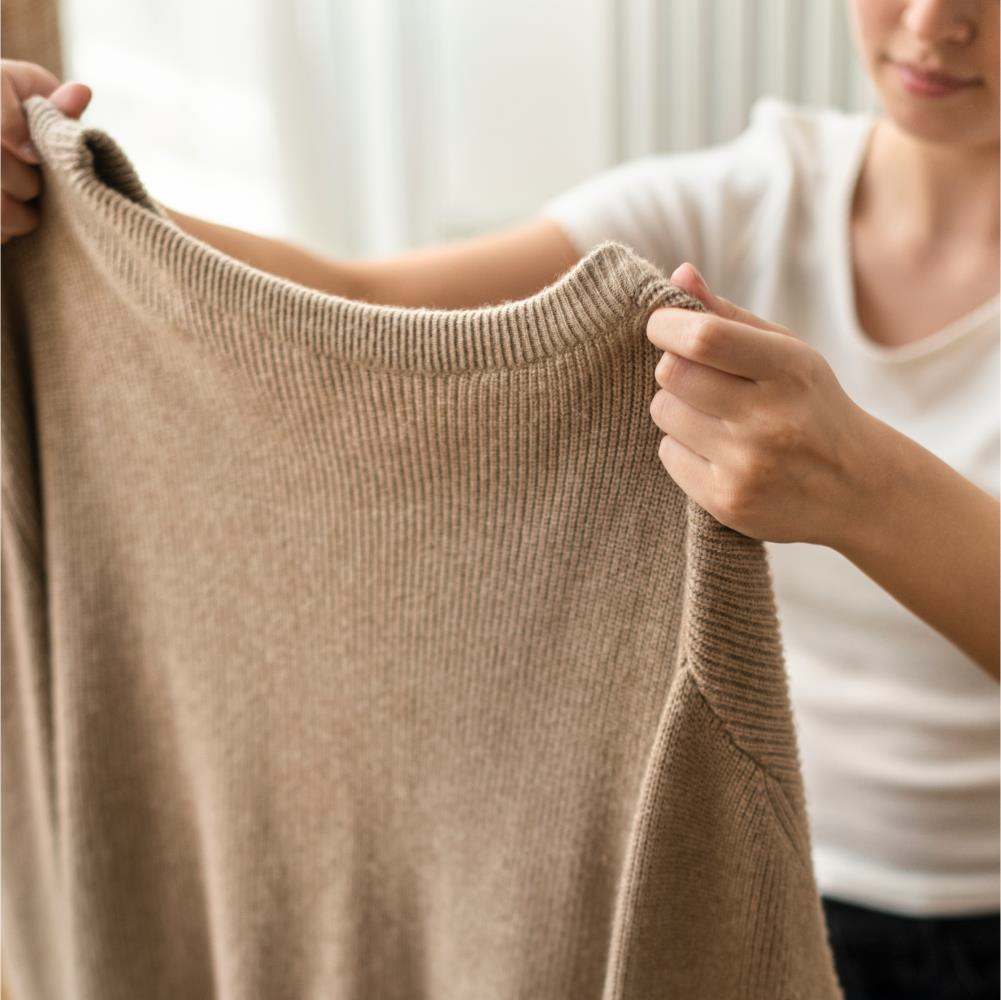As a rarely-ever-dressing-up kinda gal, I typically don’t pay much attention to fabric pilling or lint- that is, until I take out my cotton sweaters, hoodies, and jumpers from the wardrobe- just to see them become a scrubby mess with lint all over their surfaces.
So, to deal with these linty issues and find the best cotton lint remover for you in the process, I took some time to test the best lint remover for clothes. In this clothing care guide, I will share what solutions I found to be really effective for lint removal, and the ones that you should always avoid. Let’s get started!
Difference between Lint and Fabric Pilling
Before we start digging into solutions, it’s essential to identify what lint actually looks like. In most cases, your clothing can be covered with fabric pilling- which is a different problem altogether. So, no matter how effective your cotton lint remover is, it won’t work if the fabric doesn’t have lint on it. Makes sense, right?
Now the question is: how can you identify if its lint or pills on your clothing? Pilling appears when tiny pieces of fabric or lint raise up and get knotted with each other to form pesky little balls of fibre clinging to the surface of your clothing. Typically, it appears in areas with excessive wear, and friction (where clothing rubs together).
On the other hand, lint is just tiny pieces of fibres, dust, or other materials that accumulate on the surface of your clothing. It is loose and sticks with friction, making it slightly annoying to remove- but mind it, it’s still easier than fabric pilling.
Option 1: Scouring Pad
Who could have thought- scouring pads or as you may know them, the scratchy green sponges that you use to scrub your pots and pans could be one of the best lint remover for clothes? Just dampen a new scouring pad so it softens a bit, then get rid of all the lint from your clothing like a pro.
The best part about this method is that its not only effective, but also really quick. Plus, who doesn’t have a scouring pad already in their homes? You can use this lint remover for wool hats and jackets, which can also extend the break between your dry-cleaning trips.
Option 2: BIORESTORE cotton
If your clothing is made of cotton and has both lint and pilling on it, here comes BIORESTORE to save your damsel (wardrobe) from distress. Simply pick your clothing with lint or pilling on it, sort it according to colour, and add it to the washer. Then, add the recommended amount of BIORESTORE Re-Tergent directly in the washer as it can stop working if combined with regular detergent in the dispenser. Run a cycle at 40ºC for 2 hours. Once the cycle is finished, toss the clothing in a tumble-drier…and done!
The thing I love most about BIORESTORE cotton is that it also revives the texture and handfeel of your cotton clothing without any extra hassle. That’s right! All of the fabrics in your wardrobe that feel a little too preloved can be restored easily with this laundry powder, making it easier-thanever to embrace sustainable fashion.
Option 3: Wool ball
Wool balls are added in the dryer to reduce and remove lint from your laundry loads. All you have to do is rub a clean dryer ball across your fabric covered with lint. You’ll be honestly shocked to see just how easy it is to remove lint this way.
While we’re at it, here’s another great use of wool balls. They are great laundry care additives to reduce drying time of your clothing.
Option 4: Dryer sheets
It kinda makes sense that dryer sheets with their antistatic laundry properties would be able to effectively remove lint from your clothing even when used outside of the dryer. But while some people claim that you can just wipe a dryer sheet on your clothing for instant lint-free results, I’ve found this to be a blatant lie.
On the contrary, dryer sheets are actually packed with multiple harmful chemicals which can make your clothing even more susceptible to lint and fabric pilling in the longer run. So, unless you want your clothing to look like a shabby and linty mess, I’d strongly recommend against using dryer sheets in your laundry care regime.
Option 5: Masking Tape
Fresh out of the laundry and covered in fluff or pet hair? Don’t worry! Masking tape can do just the trick! Just use the sticky side of the tape to pick up every piece of lint from your garments, resulting in a fur-free outfit!
While this cotton lint remover works great for fluff and (especially) dog hair, it’s not really sustainable. If you think about it- each piece of the masking tape looses stick quickly, so you need to replace them after every use which translates to excessive plastic waste.
If you still want to go down this route, I recommend using the wildest tape you can find, ideally more than 3 inches wide, so you can complete the process faster.
How to prevent lint on clothes?
If your clothing often comes out of the laundry covered in lint and fluff, it’s time to refresh your laundry care regime.
For starters, properly sort and prepare your clothing before tossing them in the washing machine black thobes for men. Make sure that there are no tissues or dirt left in any of the pockets, otherwise, lint will get transferred to all of the pieces in the laundry cycle. Wash your clothing (especially the dark-coloured ones) inside out. This way, even if the fabric catches some lint or fluff, it won’t appear on the visible side of the fabric. Also, use a “mild” or “gentle” laundry powder for washing your clothing. The lesser the wear, the lesser the lint!





